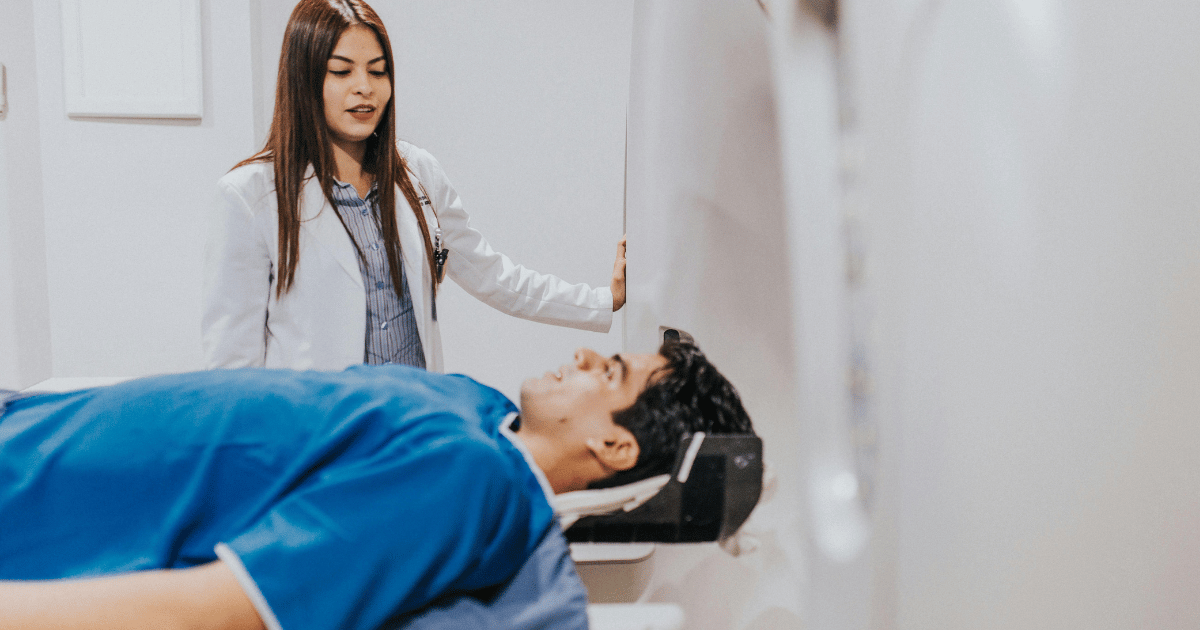Back pain can be frustrating, limiting, and disruptive to daily life. For some, it’s an occasional ache that goes away with rest; for others, it lingers or worsens over time, causing significant concern. Back pain can arise from issues in the lumbar spine, including conditions like sciatica, spinal stenosis, or a herniated disc.
One of the most valuable tools doctors use to uncover the root cause of persistent pain is magnetic resonance imaging (MRI). The benefits of MRI include providing detailed images that help with accurate diagnosis and effective treatment planning. But not every patient with back pain automatically needs an MRI. Knowing when to seek this diagnostic scan—and what red flags to watch for—can guide patients toward timely care and the right treatment plan. Guidelines from organizations such as the American College of Physicians recommend MRI only when certain criteria or red flag symptoms are present, ensuring appropriate use of imaging for back pain.
Introduction to Back Pain Diagnosis
Back pain is one of the most common health concerns, affecting millions of people and often interfering with daily activities and overall quality of life. Diagnosing the source of back pain can be challenging, as it may result from a variety of causes such as injuries, degenerative changes, or even infections. Magnetic resonance imaging (MRI) scans have become an essential tool in the evaluation of back pain, especially when it involves the lumbar spine. An MRI scan uses powerful magnets and radio waves to create detailed pictures of the spine, allowing physicians to see the soft tissue structures—including the spinal cord, nerves, and discs—that are not visible on standard X-rays. This advanced imaging helps doctors determine the underlying cause of pain, whether it’s a herniated disc, nerve compression, or another issue, and develop a targeted treatment plan to improve patients’ health and quality of life.
Understanding Red Flags
Most cases of acute back pain improve with rest, stretching, or conservative treatment. However, there are certain “red flags” that signal something more serious may be happening in the spine.
Red flags that may warrant an MRI include:
- Severe or progressive neurological symptoms (numbness, weakness, or loss of bladder/bowel control)
- Fever combined with back pain (possible infection)
- A history of cancer with new back pain
- Significant trauma or recent accident
- Unexplained weight loss alongside chronic back pain
When these symptoms appear, they require urgent evaluation. Doctors also consider risk factors such as age, medical history, and medication use to determine if advanced imaging is necessary. An MRI can help detect conditions like spinal cord compression, fractures, infections, or tumors in the spine that may require immediate intervention.
Symptoms of Low Back Pain
Low back pain can present in a variety of ways, ranging from a sudden, sharp discomfort known as acute low back pain to a persistent, ongoing ache that characterizes chronic low back pain. Common symptoms include pain in the lower back, which may radiate to the buttocks, thighs, or even down the legs. Some patients experience numbness, tingling, or weakness in the legs, which can signal nerve involvement. In more severe cases, symptoms such as loss of bowel or bladder control, fever, or a history of recent trauma may appear—these are considered red flags and require immediate medical attention. Sciatica, a frequent companion of low back pain, occurs when the sciatic nerve is compressed or irritated, leading to pain, numbness, or tingling that travels down one or both legs. Recognizing these symptoms is crucial for timely diagnosis and effective treatment.
Diagnostic Tools for Back Pain
Doctors use several tools to evaluate the spine. X-rays are often the first step, useful for detecting fractures or alignment issues. Computed tomography (CT) scans provide more detail and have traditionally played a significant role in spinal imaging, but expose patients to radiation.
MRI, by contrast, offers the most detailed view of soft tissue structures—discs, ligaments, spinal nerves, and the spinal cord itself—without radiation. Spinal imaging includes various modalities, but spinal MRI is the most advanced procedure for evaluating soft tissues and diagnosing spine-related conditions. This makes it especially helpful for diagnosing:
- Herniated discs causing nerve irritation
- Spinal stenosis narrowing the spinal canal
- Degenerative disc disease leading to chronic back pain
- Spinal deformities, infections, or tumors, for which spinal MRI is the preferred procedure
In complex cases, multiple MRIs (mris) may be performed to monitor changes or guide treatment.
For many patients with persistent or worsening back pain, an MRI provides the clarity needed to move forward with a treatment plan, whether that means pain management or a surgical option such as minimally invasive spine surgery. Diagnostic tests, including imaging procedures and laboratory tests, are used to rule out serious causes of back pain.
The Lumbar Spine and Low Back Pain
The lumbar spine is one of the most common sources of pain. The spinal column, composed of five vertebrae and cushioning discs, supports the body and protects the spinal cord while bearing much of the body’s weight and enabling movement. When these discs become damaged or compressed, they can cause radiating pain, numbness, or weakness in the legs.
MRI scans of the lumbar spine are particularly effective for uncovering:
- Disc herniations
- Stenosis causing nerve compression
- Spinal deformities affecting posture and function
It is important to note that degenerative changes, such as dehydrated discs, are often observed in asymptomatic patients, so imaging findings should always be correlated with clinical symptoms.
Patients with mild, short-term low back pain may not need imaging at all. But for those whose symptoms persist or worsen, MRI helps pinpoint whether the issue is muscular, structural, or neurological. A systematic review supports the use of MRI for accurately diagnosing specific lumbar spine conditions.
Causes of Low Back Pain
Low back pain can arise from many sources. Acute pain may develop suddenly after lifting or a fall. Chronic pain often stems from gradual changes, such as degenerative disc disease or arthritis.
Other causes include:
- Pinched nerves from compressed spinal structures
- Spinal cord compression from injury or deformity
- Infection or cancer, which require urgent evaluation
Because the causes are so varied, a careful medical history and physical exam come first. If concerning features are found, imaging—especially MRI—becomes essential to help determine the underlying cause of back pain. MRI can help diagnose specific conditions, such as ankylosing spondylitis or nerve compression, that may require different treatment approaches. MRI findings also help physicians decide how best to treat the patient’s symptoms.
Conservative management is often the first step. Exercise is frequently recommended as an initial treatment for low back pain, as it can provide temporary relief and improve symptoms.
Preparing for a Diagnostic Procedure
Before having an MRI scan, it’s important for patients to communicate openly with their doctor about any metal objects or implants they may have, such as pacemakers, artificial joints, or cochlear implants, as these can affect the safety and quality of the imaging. All metal items, including jewelry, watches, and eyeglasses, should be removed prior to the scan. In some cases, a contrast dye may be used to enhance the images, so patients should inform their doctor about any allergies or sensitivities. The MRI technologist will provide instructions and support throughout the procedure, ensuring patients remain comfortable and still to obtain the most accurate images. Additionally, patients should be ready to share a detailed medical history, including any previous injuries, surgeries, or relevant health conditions, to help the medical team tailor the imaging and interpret the results effectively. This preparation helps ensure a smooth experience and the best possible outcome from the MRI scan.
What to Expect During an MRI Scan
The MRI procedure is simple and non-invasive. Patients lie on a table that slides into the scanner, which uses powerful magnets and radio waves to create detailed images.
- The scan usually takes between 20 minutes to an hour.
- Metal jewelry, watches, or glasses must be removed beforehand.
- Leg braces or other external devices may need to be removed before the procedure.
- In some cases, a contrast dye may be used to highlight certain tissues.
- The technologist monitors the patient throughout, providing instructions to stay still and comfortable.
While MRI is generally safe, patients with certain metal implants may require alternative imaging. Your physician will determine if MRI is the right choice. However, it is important to be aware of potential risks, such as magnetic interference with implants, allergic reactions to contrast dye, or other complications that may arise during MRI procedures.
Next Steps for Back Pain Patients
Not every backache requires advanced imaging, but when symptoms persist, worsen, or present with red flags, an MRI can be a critical step in getting answers. Timely and appropriate imaging can improve patient outcomes by guiding effective treatment. Accurate diagnosis is the key to effective treatment and long-term relief.
At ISSI, we help patients by determining when imaging is appropriate and guide them through next steps. If you’ve been struggling with unresolved back pain, start today with our Pain Assessment Tool or request a Free MRI Review to see if advanced imaging could help you.


